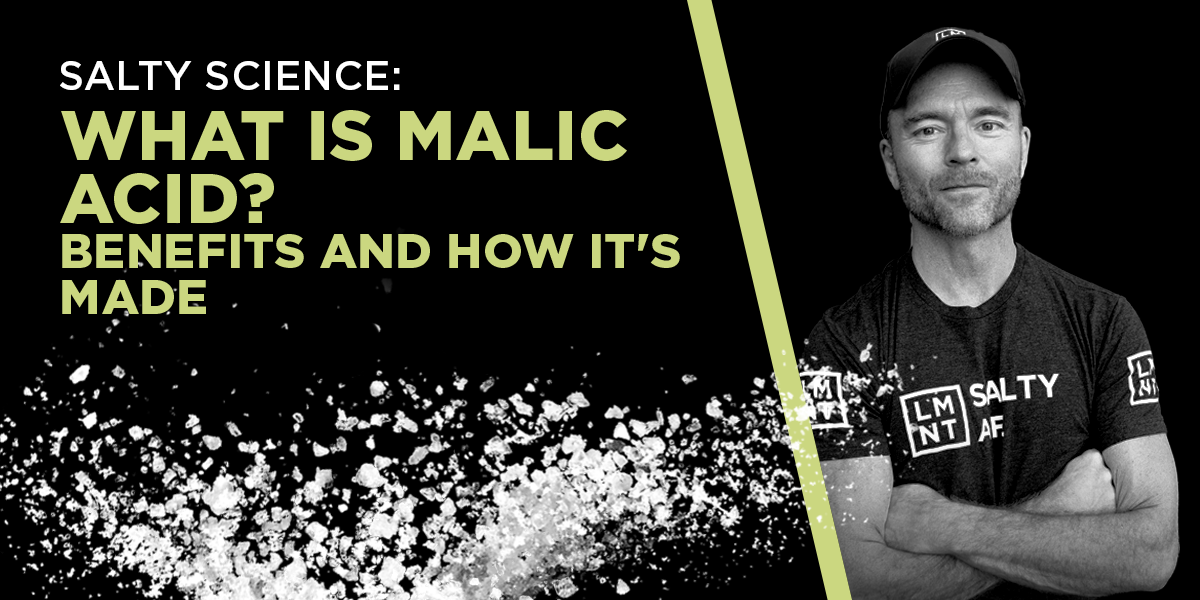You’ve probably seen malic acid countless times on food, beverage, and supplement labels. What is that stuff, anyway?
Malic acid is an organic acid found in fruit. It’s used in foods to add flavor, and in supplements to enhance absorption.
In fact, we use magnesium malate (malate is a malic acid derivative) in LMNT. I prefer this form of magnesium over, say, magnesium oxide because it’s better absorbed and it tastes better.
Beyond helping minerals enter your body, malic acid has some cool potential health benefits. For instance, it’s is an intermediary in the citric acid cycle, the process by which your cells constantly produce energy (ATP). Unsurprisingly, there’s evidence that supplementing with malic acid improves energy production during exercise.
Consuming malic acid has other benefits too. I’ll cover those later, along with its overall safety profile. First, though, let’s explore the basics of malic acid: What it is, how it’s made, and where it’s used.
What Is Malic Acid?
Malic acid is a type of organic acid called an alpha-hydroxy acid, a term that refers to its chemical structure. Other alpha-hydroxy acids include citric acid, lactic acid, tartaric acid, and glycolic acid.
Malate, in case you were wondering, is simply a derivative of malic acid. For our purposes, let’s consider them to be the same.
The citric acid cycle (also known as the TCA cycle and the Krebs Cycle) is responsible for producing cellular energy in the form of adenosine triphosphate (ATP). Malate is an important part of this cycle. Specifically, malate is a precursor to citrate, a key ingredient for producing ATP.
Fun fact: Malic comes from the Latin “malus,” which means apple. The more sour the apple, the higher the malic acid content.
Malic acid is also the main acid in many other fruits, including cherries, blueberries, blackberries, apricots, peaches, pears, plums, and grapes. Citrus fruits, on the other hand, contain higher levels of malic acid’s cousin: Citric acid.
History and Production of Malic Acid
In 1785, Carl Wilhem Scheele discovered malic acid in apple juice. Two years later, the French chemist Antoine Lavoisier named it “acide malique,” which is French for malic acid.
Today, malic acid is widely used in the food and beverage industry as a preservative and natural flavoring agent. It’s also used to bind compounds in drugs and supplements, and in certain skincare products.
Malic acid is formed naturally in plants, but can’t be extracted in a cost effective way. That’s why people manufacture it. Here are the top methods:
- From benzene. First, benzene is converted to maleic acid. The maleic acid is then heated and pressurized to form malic acid, maleic acid, and fumaric acid. The malic acid is then separated and purified through washing, evaporation, and crystallization.
- From fumaric acid. When you combine fumaric acid (another organic acid) with hot water, you can make malic acid.
- Through fermentation of sugars. Several microbes produce malic acid as a byproduct of sugar fermentation.
While all of these methods produce essentially the same malic acid, the fermentation method is the most cost effective and eco-friendly option. Researchers are currently experimenting to optimize this newer form of malic acid production.
Products That Contain Malic Acid
All fruits (and many vegetables) contain malic acid. Interestingly enough, the method of farming seems to affect malic acid levels. In one analysis, organically farmed citrus fruit had more malic acid compared to conventional counterparts.
Malic acid also occurs naturally in wine. Nobody likes sour wine, though. So when wine is fermented, the malic acid is converted to the milder lactic acid. This process is called malolactic fermentation.
Manufactured malic acid, on the other hand, is most commonly found in:
- Food products. Because it has antimicrobial properties, malic acid is a common food preservative. Both mayonnaise and salad dressing, for instance, often contain malic acid to increase shelf life and add acidity. Malic acid is usually the secret ingredient in super sour candies.
- Beverages. Low-calorie beverages often contain either citric acid or malic acid. They trick the brain into thinking there’s more fruit flavor than there really is. Both acids have a similar sourness, but malic acid is slightly cheaper per unit volume.
- Supplements. Manufacturers bind minerals to malate to enhance bioavailability.
- Skin care products. Malic acid is a common ingredient in peels and other skin care products. In one study, a malic acid skin care regimen combined with a vitamin C-based mask improved melasma (brown sun spots) in 35 patients.
Health Benefits of Malic Acid
Malic acid isn’t just a flavoring and preservative. It also offers health benefits. Here are the most promising:
#1: Enhanced mineral absorption
When malic acid is attached to a mineral—be it potassium, magnesium, or calcium—it helps you absorb that mineral through the gut and into the bloodstream. In rats, magnesium malate was absorbed better than magnesium citrate, magnesium sulfate, and magnesium oxide.
As I mentioned earlier, magnesium malate is the form of magnesium in LMNT. It adds a pleasant tartness, plus it helps people absorb magnesium better. Win-win.
#2: Kidney stone prevention
In one small study, eight healthy people were given 1,200 milligrams of malic acid each day for seven days. When the week was up, the patients had higher levels of citrate (which binds calcium) in their urine than they had at baseline. They also had lower levels of calcium and calcium oxalate, both kidney stone precursors. “We conclude,” write the authors, “that malic acid supplementation may be useful for conservative treatment of calcium renal stone disease.”
#3: Fibromyalgia Relief
Fibromyalgia is a condition defined by chronic, diffuse pain across the musculoskeletal system. What’s more, sufferers often report problems with sleep, energy, and cognitive function.
One randomized and controlled trial on 24 fibromyalgia patients suggests that malic acid can help. To be clear, four weeks of malic acid supplementation had no effect on pain and tenderness in this population. But the trial didn’t stop after four weeks.
Rather, it continued as an “open label” (non-blinded) intervention for several months. After this longer duration, the patients reported significant symptom relief. To be reasonable, this deserves more investigation—both as to why benefits were seen long after four weeks, and also to account for any potential placebo effect.
#4: Energy production
Recall that malate fuels the citric acid cycle. Think of this cycle, if you will, as your internal combustion engine. It takes non-usable fuel (food) and turns it into usable energy. This usable energy is called adenosine triphosphate, or ATP.
As a general rule, anything that boosts ATP production should also boost energy. One old study (on rats) found that malic acid salts improved exercise performance and recovery. Another study found that creatine malate supplementation improved performance and growth hormone levels in sprinters. But to be clear, creatine (not malate) could, and likely did, drive this effect.
Finally, 18 men complaining of fatigue showed improvements in energy and ATP production after taking citrulline malate supplements for 15 days. These benefits, according to the paper, may be due to “an enhanced malate supply activating ATP production.”
#5: Heart health
Animal experiments suggest that both citric acid and malic acid can improve heart disease risk factors. In a rat model of heart injury, supplementing with malic acid significantly reduced:
- Blood levels of an inflammatory biomarker called TNF-α
- The aggregation of platelets, a cell fragment involved in clotting
- The size of myocardial infarction (aka heart attack)
All of these are positive changes, but more research in humans is needed.
Malic Acid Safety
Malic acid is generally recognized as safe (GRAS) by the United States Food and Drug Administration (FDA). When a compound is given a GRAS designation, it means that experts have decided that it poses little to no health risk at normal levels of consumption.
Malic acid has also been awarded a “green circle” by the Environmental Protection Agency (EPA). This simply means that, based on experimental data, the EPA isn’t concerned with the safety profile of this chemical.
Another promising data point: The fibromyalgia study referenced earlier suggests that fairly high doses of malic acid can be taken for up to six months without adverse effects. These doses were orders of magnitude higher than what you’d find in foods and beverages.
Avoid getting malic acid in your eye (I know, tempting!), or placing the undiluted chemical directly on your skin. Beyond that, there’s little to worry about with malic acid.
Is Malic Acid Healthy?
I hope this article helped demystify malic acid for you. In summary, malic acid:
- Occurs naturally in fruits, giving them their tart flavor.
- Can be produced via several methods, including fermentation.
- Appears in foods, beverages, and supplements as a flavoring agent, acidulant, preservative, and absorption enhancer.
- May, in sufficient quantities, reduce the risk of kidney stones, improve energy, and decrease fibromyalgia symptoms.
- Is considered safe by the FDA and EPA.
One last point. I wouldn’t use malic acid (as magnesium malate) in LMNT if I wasn’t 100% certain it was safe and healthy. After all, my whole family relies on LMNT for their electrolytes.
Okay, that’s it for today! Thanks for reading, and I hope you learned something useful. If you’d like, read up on stevia or citric acid next—I covered these flavor enhancers in detail.

